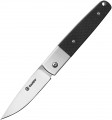Design
-
Clumsy. The simplest option: the knife blade is fixedly fixed in the handle; there is no possibility of folding it. Such knives are not very convenient to carry - not only because of their large dimensions, but also because they require a sheath or sheath, otherwise the blade can damage surrounding objects or even injure the owner. On the other hand, the fixed structure is simple and inexpensive - and at the same time extremely durable and reliable. Therefore, many knives designed for significant loads - in particular, hunting and fishing ones - are made awkward.
—
Folding. Knives of a traditional folding design: during non-working hours, the blade is folded due to the rotary fastening in such a way that the blade is hidden in the handle. A similar folding principle is used by butterfly knives and multitools (see “Type”), so they also fall into this category. In any case, this design significantly simplifies storage and transportation and reduces to almost zero the likelihood of the blade coming into contact with foreign objects. Folding models are considered somewhat less durable and reliable than non-folding ones; however, through the use of certain types of locks (see below), this moment can be almost completely compensated. But the obvious disadvantages of this design are its higher cost than non-folding ones, as well as the need for special maintenance: a dirty mechanism may require cleanin
...g and lubrication. In addition, not every knife can be made folding - for example, for a machete this does not make sense given the size and purpose.
— Folding (front-facing). A specific type of folding design, found mainly in EDC knives (see “Type”). The difference between such products and conventional folding knives is that when opened, the blade does not rotate on a hinge, but extends from the front end of the handle, usually under the action of a special spring. Moreover, in the simplest models the spring works only in one direction - usually to open, less often to close; you have to move the blade in the other direction and compress the spring “manually”, by moving a special slider or other element. However, the two-way Double Auto system has become more widespread (for more information about it, see “Lock”). Note that in order to avoid injury (or stabbing), in some “front-end” blades the blade can be removed from the lock and moved back also under the influence of strong longitudinal pressure.
— Folding (automatic). Knives with an automatic mechanism for unfolding and folding the blade. To bring their blade into working position, a lock with a powerful spring is used, which is released when the button is pressed. The key feature of automatic folding models is the ability to open them with one hand. A knife with automatic blade ejection often comes to the rescue when it is not possible to use the second hand. As a rule, opening and closing the blade of such knives occurs using a button.Anti-glare blade coating
The presence of an
anti-glare coating on the knife blade. The most popular color for such blades is black, but there are other options, including even white. The main purpose is to prevent glare from the blade that can reveal the knife's owner or create inconvenience during use. This is especially important during hunting and similar activities, which is why this feature is often found in hunting and fishing models (see "Type") as well as "survival" knives. At the same time, it doesn't stop there. For example, matte coating is also used in
multitools, and here it primarily concerns convenience during work. In some knives, such blades play more of an aesthetic role, giving the product a stylish appearance or resembling a military model.
Hardness
The hardness of the material used for the knife blade. This parameter is one of the key characteristics of the blade. On the one hand, high hardness means that the cutting edge will not deform, wrinkle and dull prematurely, and the blade itself will bend under transverse loads; on the other hand, hard material is difficult to sharpen and is often rather brittle.
For knife blades, Rockwell hardness measurement and designation according to the appropriate scale (HRC) are used. Most good quality steel knives have a hardness of around 52 - 58 HRC - this range is considered to correspond to the optimal ratio of characteristics. For other materials, the numbers can be noticeably lower without any noticeable loss of reliability; see "Blade material" for details. And
hardness above 60 HRC is extremely rare - mainly in premium grade steels and higher. In such steels, the brittleness characteristic of hard materials is eliminated through the use of various high-grade additives, and the difficulty in sharpening is compensated by the blade's long service life.
It is worth remembering that hardness is not the only characteristic that determines the quality of the blade: a lot depends on the composition of the alloy, manufacturing technology, etc. However, this is a fairly clear indicator that characterizes the features of a particular material; this is especially true for steel.
